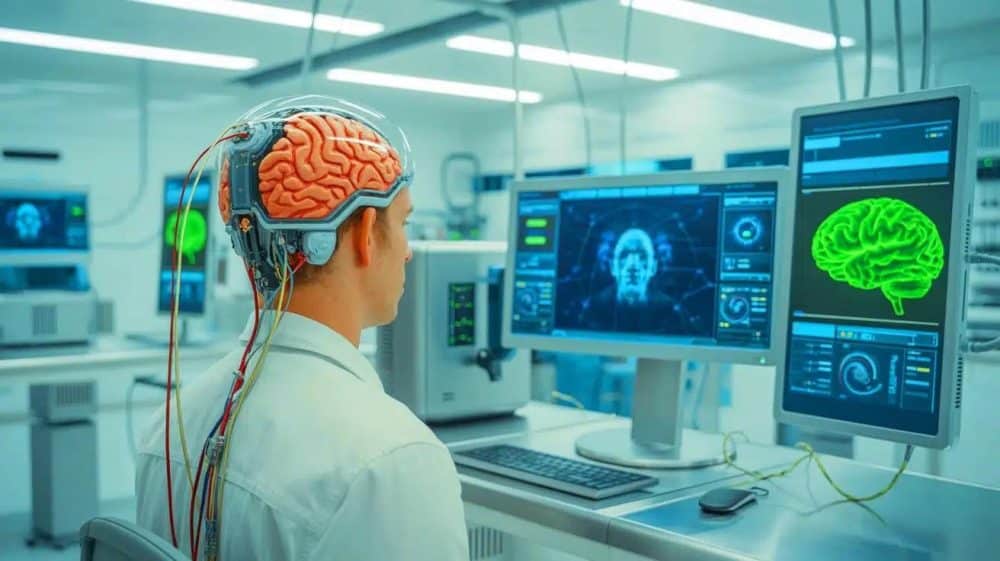If the last decade was about putting AI into everything, the next one may be about letting AI listen to our minds. What used to live in science fiction, silently “speaking” to a computer, describing a memory without moving your lips, or chatting with an assistant purely by thinking, is now starting to take shape in labs around the world.
For millions of people who have lost the ability to speak or move, this isn’t a futuristic gimmick. It’s the possibility of getting their voice back. And for everyone else, it raises a thrilling, and slightly terrifying, question: what happens when technology can finally understand not just what we say, but what we mean and imagine?
Today’s brain–computer interface (BCI) research is converging on one big goal: decoding thoughts into language. Different teams are approaching this from different angles:
- brain implants that turn inner speech into text or sound,
- AI systems that “caption” mental images and videos we see or remember,
- fast-transfer decoders that can be adapted from one brain to another,
- and commercial projects like Neuralink, which aim to plug human thought directly into digital systems.
Together, these technologies are building a toolkit that could one day let people with paralysis, aphasia, ALS, or other communication disorders express themselves as fluidly as anyone else, and perhaps even give healthy users new ways to interact with machines.
Below is a look at where we are now: the key technologies, what they could do for people with disabilities, and the wider uses and risks they entail.
Inner Speech BCIs: Turning Silent Thoughts Into Speech
Scientists in the US have developed a brain implant that decodes inner speech, the words you “say” in your head, into text or spoken language.
- An implant records activity in the motor cortex, an area tied to speech and movement.
- AI models detect patterns for phonemes, the tiny sound units of language.
- These are assembled into words and sentences, with probability models filling in likely phrases.
In tests with people who have severe paralysis, the system reached up to about 74% accuracy on a vocabulary of roughly 125,000 words in the best case.
What This Means For People With Disabilities
For people who can’t speak or move:
- They may be able to “talk” just by thinking of the words.
- It could be faster and more natural than current systems based on eye movements or attempted speech.
- It brings truly conversational communication closer for people with:
- ALS
- locked-in syndrome
- severe brainstem or spinal cord injuries
Because the system listens to intended speech, not just muscle effort, it aims to tap into communication at its source – thought.
The “Mental Password” Idea
There’s a major privacy concern: no one wants their private inner monologue tapped without consent.
To address that, researchers tested a thought-based on/off switch, where users think of a special keyword to activate or stop decoding. Early experiments showed around 98% accuracy in detecting this “unlock” thought, hinting at future user-controlled mental privacy.
Mind Captioning: Writing Sentences From What You See And Imagine
In Japan, researchers are developing “mind captioning”, an AI system that translates brain activity into descriptive text about what you’re seeing or imagining.
Using fMRI scans:
- Volunteers watched thousands of short videos with scenes, objects, and actions.
- AI models learned to map their brain patterns to semantic features from video captions (via a large language model).
- Later, when volunteers watched new videos or imagined the old ones with their eyes closed, the system generated sentences describing the scenes.
The system can produce original sentences like:
“People talking while others hug”
“Someone jumping over a waterfall on a mountain”
It doesn’t just list objects; it captures relationships and actions.
Why Is This Powerful For Communication
This technology:
- Works even when language regions are not used, relying instead on visual and semantic brain areas.
- Can decode mental images and memories, not just heard speech.
For people who:
- have aphasia (damaged language areas),
- are unable to speak or write,
- or are non-verbal but cognitively intact,
Mind captioning could eventually enable people to describe what they see, remember, or imagine, turning pure mental content into readable, shareable text.
It hints at a future where someone might convey a complex scene; a memory, a dream, a pain, a fear, without needing to find the words themselves. The AI would help them build the sentences.
Shared Decoders: Training Once, Using on Many Brains
Another big step is making brain decoders usable without endless training for each individual.
Researchers at UT Austin showed that a brain-to-text decoder trained on a few people can be transferred to new users with far less data:
- A “reference” group listens to ~10 hours of stories in the scanner.
- For new participants, only about 70 minutes of:
- listening to audio, or
- watching silent Pixar films
is needed.
- Using functional alignment, the model learns how the new brain represents meaning and adapts the existing decoder.
When tested with new stories, the decoder doesn’t spit out exact sentences, but it captures the main ideas: the generated text is semantically similar to the original content.
Why This Matters For People With Communication Disorders
This approach:
- Cuts down on training time, making it more practical for patients.
- It could help people who cannot cooperate with long, demanding protocols, like those with severe aphasia or fatigue.
- Shows that visual and language information share deeper semantic codes in the brain – a key insight for future multi-modal BCIs.
Neuralink and Commercial Implants: From Therapy to Enhancement
Neuralink, Elon Musk’s company, is pushing a commercial, implantable BCI that aims to:
- capture signals in speech and motor areas,
- translate mentally formulated sentences into text or commands in real time,
- and restore communication for people with severe paralysis or speech loss.
Clinical trials are beginning under FDA oversight to test:
- accuracy and error rates per word,
- latency (how fast thoughts become text),
- long-term safety and biocompatibility.
For People With Disabilities
If it works as intended, Neuralink-like devices could:
- Give people with ALS or spinal cord injury a high-bandwidth, always-available communication channel,
- Replace eye-trackers, switches, and typing systems with direct thought-based interaction.
The Transhumanist Leap
But Neuralink’s vision goes further:
- In the longer term, implants might be offered to healthy people,
- allowing them to communicate with AI or other devices at “mind speed”,
- possibly even receiving information directly into the brain.
This moves from therapy (restoring a lost ability) to enhancement (adding new ones), raising tough questions about:
- what it means to be human,
- equality (who gets upgraded?),
- consent and data ownership,
- dependence on commercial platforms to literally mediate our thoughts.
Beyond Disability: Wider Uses and New Risks
While the most urgent benefits are for people with disabilities, the same technologies open many broader possibilities:
New forms of communication
- Thought-to-text and mind captioning could let anyone:
- draft messages, notes, or prompts without typing,
- describe complex internal imagery quickly,
- communicate even when physically unable to move or speak.
Understanding internal experiences
- Decoding mental content could help:
- explore dreams, visual imagination, and memory,
- study conditions like PTSD, depression, or hallucinations,
- give clinicians a richer picture of what patients experience but cannot describe.
Brain–AI collaboration
- Direct thought interfaces would allow:
- faster control of AI tools, robots, or software,
- seamless interaction with text-based models,
- new creative workflows where ideas flow straight from brain to digital canvas.
The “Ultimate Privacy Challenge”
At the same time, experts warn this could be the most extreme privacy problem we’ve ever faced:
- Brain data contains not only current thoughts, but also:
- signatures of mental health,
- early signs of neurological disease,
- deeply personal preferences and reactions.
That’s why many ethicists and neurorights advocates argue for:
- treating neural data as sensitive by default,
- requiring explicit, purpose-limited consent,
- building user-controlled unlock mechanisms (like mental passwords),
- and developing new legal frameworks specifically for brain data and AI.
For now, these systems still require cooperation, bulky scanners or surgery, and extensive training, so they cannot silently read random thoughts in the wild. But the pace of progress means rules and protections need to evolve now, not after the tech is everywhere.
A New Voice for the Silent, And A New Responsibility For Everyone
Taken together, inner speech decoders, mind-captioning, shared brain models, and Neuralink-style implants mark a turning point:
- For people who cannot speak or move, they offer the promise of real-time, natural communication built from thoughts, images, and intentions.
- For science, they reveal how meaning is encoded across the brain, beyond just language areas.
- For society, they force us to rethink privacy, consent, and the boundary between human and machine.
Decoding thoughts is no longer science fiction. The real question now isn’t just “Can we do it?” but “How do we use it to restore human dignity and ability, without sacrificing mental freedom along the way?”


